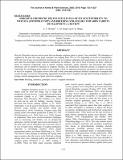| dc.contributor.author | Mwenda, Emmanuel T. | |
| dc.contributor.author | Ringo, Justin Hanson | |
| dc.contributor.author | Mbega, Ernest | |
| dc.date.accessioned | 2021-06-15T07:20:56Z | |
| dc.date.available | 2021-06-15T07:20:56Z | |
| dc.date.issued | 2020-10 | |
| dc.identifier.issn | 1018-7081 | |
| dc.identifier.uri | https://dspace.nm-aist.ac.tz/handle/20.500.12479/1246 | |
| dc.description | This research article published by The Journal of Animal & Plant Sciences | en_US |
| dc.description.abstract | Weevils (Sitophilus spp) are serious pests that can damage sorghum grains in stores if not controlled. The infestation of
sorghum by the pest can cause huge economic loss ranging from 15% to 75% depending on levels of susceptibility.
While the weevil uses several infection mechanisms such as avoidance, adaptation and sequestration to arrest its host, the
host plant has developed certain chemical mechanisms for defence. The weevil must overcome the hosts’ defensive
layers of chemical compounds such as protein resistant molecules, tannin, phenolics and flavonoids that confer
antixenosis and or antibiosis functions in sorghum. Besides, the biochemical molecules present in sorghum are also
responsible for modulating grain hardness and strength, which are important phenotypic parameters for grain resistance
to weevil in sorghum. This paper reviews traits and or their associated produced chemical compounds in sorghum and
reveals the gaps or need for incorporating appropriate desirable traits in sorghum through plant breeding techniques as a
strategy towards management of grain weevils in sorghums. | en_US |
| dc.language.iso | en | en_US |
| dc.publisher | The Journal of Animal & Plant Sciences | en_US |
| dc.subject | Weevil - sorghum interaction | en_US |
| dc.subject | Genotypes | en_US |
| dc.title | Sorghum chemistry delineates levels of its susceptibility to weevils (sitophilus spp) and breeding strategies towards variety development; a review | en_US |
| dc.type | Article | en_US |

